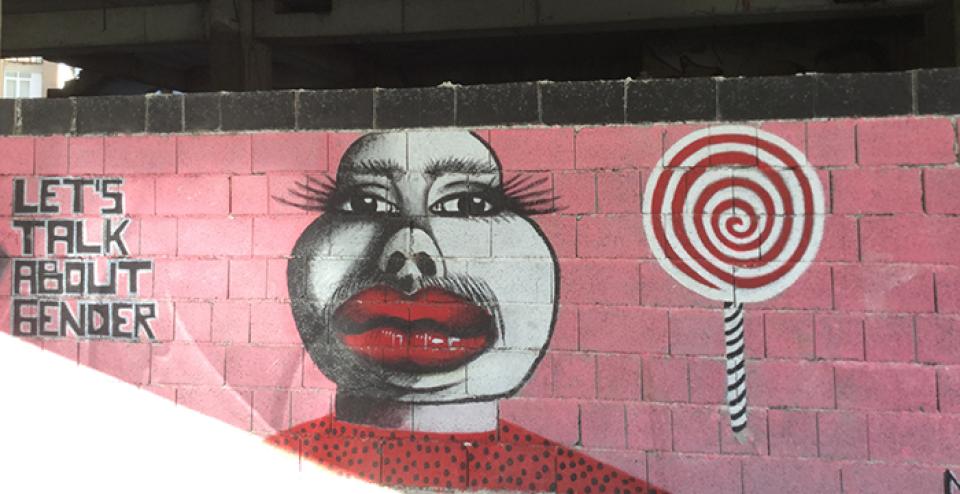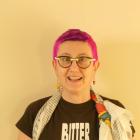
Grafitti in Mostar, Bosnia.
Or let us now have a non-binary debate on online violence
We all know feminism and the world do not go hand-in-hand on many things, especially if trying to address violence against women in the virtual world. Platforms, codes and cultural settings seem to conspire against any real, concrete and timely solution, putting most often women and beyond-binary(1) self-identifying individuals on the side of protectionist censorship. It is like we, the women/girls and beyond-binary self-identifying individuals, are not strong enough to cope with the “real” world, and so ask for protection of the state or corporation, thereby silencing free speech. This frame implies that free speech is somehow enriched by statements such as “slut-will-rape-you-and-put-a-rat-into-your-hole-you-bitch” and images that usually accompany them, that are often put and shared online by many accounts (whether these are bots or humans is irrelevant).
As a feminist, I know I have no sense of humour to understand the exquisite arguments behind such florid vocabulary or the political acuteness to understand the public rights relevance of such arguments, therefore I apologies for desiring a world without violence and that there be less space for threatening interactions online.
The truth is the conversation on freedom of speech and violence against women/girls and beyond-binary self-identifying individuals is already inscribed in the concept of limitation or restriction on freedom of speech’s conception i.e. in the balancing of rights. But we still conduct a logical debate on balancing the right to express of a (male) person versus the right not to be harassed of another person, or their right not to become the target of incitations to violence, hate speech and in the worst cases death treats and death.
While freedom of expression has been a vital part of public discourse, and been internalized and legislated as a fundamental human right, the issue of violence against women has been brought from the private to the public domain only recently – thanks to years and years of activism and political advocacy by feminists.
It is this uneven position that makes it possible that even today it is questionable whether we can ensure justice and eradicate violence. That is why ending online violence had being framed as a feminist principle of the internet, to give it the symbolic and political relevance that it deserves and to call all actors to not only acknowledge the existence of violence but to accept and act upon it:
[Feminist Principles of the Internet 17]: Online Violence – We call on all internet stakeholders, including internet users, policy makers and the private sector, to address the issue of online harassment and technology-related violence. The attacks, threats, intimidation and policing experienced by women and queers are real, harmful and alarming, and are part of the broader issue of gender-based violence. It is our collective responsibility to address and end this.
The world is intrinsically intersectional: gender, race, class, age, ability should not be dissolved and sacrificed to existing abstract, logical legislative norms. These legal norms are allegedly neutral but were put in place by a predominantly western, white, hetero-normative, male hegemony. This explains why there is even now a obstinate bianarian discussion on free speech that has not been unpacked, a discussion that pits a basic human right such as freedom of speech against confronting violence against women.
The framing determines upfront the outcome of the conversation. In most international and national laws there is acceptance of legitimate restrictions or limitations on the right to free speech, and this is the prevailing understanding in any discourse on free speech as well. What I am pushing here is to further unpack this debate from a feminist perspective and practice, that bring back people and bodies into this discussion.
Bulletproof Ideas
Beneath this mask there is more than flesh. Beneath this mask there is an idea, Mr. Creedy. And ideas are bulletproof. – V, V for Vendetta
I loved V for Vendetta, the movie and I could recognize a younger myself in V’s speech. There is something compelling about bulletproof ideas that remain and that in time other people and other bodies will bring them forward. We need to understand that free speech is about ideas, while violence is always about bodies.
What legislators, advocates, regulators and policy-makers fail to see is the power of brutality and violence to silence and even to annihilate the body of the assaulted person. That it is virtual, does not make the attack any less real or painful. Our data selves and online bots inscribe our bodies in our physical realities with a terrific precision. The online is not virtual, virtuously removed from the body – it is inscribed in the same patriarchal world that will use any argument to silence diversity, while allegedly upholding free speech.(2)
If we look at the definition of technology-related violence, feminist digital rights activists talk of freedom of expression. They explicitly add the experience of the body to this articulation – what is included is the physical and sexual dimensions of self expression, whether in politics or entertainment, whether individually or collectively.
Technology related violence against women/girls and beyond-binary-self-identifying individuals – such as cyberstalking, harassment and misogynist speech – encompasses acts of gender-based violence that are committed, abetted or aggravated, in part or fully, by the use of information and communication technologies (ICTs), such as phones, the internet, social media platforms, and email. Technology-related violence against women is part of the same continuum as violence against women offline.
That’s why the FPI on freedom of expression explicitly includes sexual expression as an essential dimension of the right to freedom of expression, even if it is usually invisibilized in other discourses of the state or in international discourse.
[FPI 10] Freedom of expression – We defend the right to sexual expression as a freedom of expression issue of no less importance than political or religious expression. We strongly object to the efforts of state and non-state actors to control, surveil, regulate and restrict feminist and queer expression on the internet through technology, legislation or violence. We recognise this as part of the larger political project of moral policing, censorship, and hierarchisation of citizenship and rights.
Violence is often against the sexualized body or the projected sexual identity of the twitter handle or FB profile under attack . It’s not just a neutral quarrel between individuals, it is a gender based offense that is protected by patriarchal and heteronormative societies and laws, nurtured by prevalent cultures of aggression and exclusion. We cannot talk about online violence without looking at the body and without understanding the texture of the violence itself. We cannot put it into a binary dimension, an either/or between ideas and the freedom to express them, and look for ways to draw a line.
The line, if one exists, is inscribed in the experienced violence of the survivors or those who have been attacked. As feminist, we know that our practice must be to listen to the lived experience of the survivor, and recognize that individual experience is authentic. It is that which is the line – the lived and experienced harm. And it is as large and high and old and young as the person experiencing the attack.
We do not however have this regard for the experience of harm. As any woman and feminist knows, in the real world, survivors and victims of violence, despite declaration and statements of equality have to prove/convince the society, the police and the court that they indeed have been harmed.
The truth is that the idea of free speech and limitations on it, was conceived in a frame that disregarded the role of gender, or indeed perhaps of any other kind of inequality (race, caste, ability etc.)
The meta-question is how harm can be proved in societies, police and court, and by whom, when even at their best these systems are gender-blind and ordinarily patriarchal and misogynist. The truth is that the idea of free speech and limitations on it, was conceived in a frame that disregarded the role of gender, or indeed perhaps of any other kind of inequality (race, caste, ability etc.) It was definitely not recognized that violence was enacted usually against one or particular genders, and its consequences are overwhelming dangerous for more than half the people who live on this planet.
In the real as in the online world women and beyond-binary self-identifyIng individuals are punished because of their gendered bodies, and free-speech with no feminist lens is the perfect tool to justify this.
Freedom of expression and online violence relate and echo each other in the continuum of gender-based violence. It is the gendered culture of violence we need to dismantle, and those who are advocates of free speech need to participate in reflections that encompasses a different justice. A justice that is not trapped in history, that is allegedly neutral or gender-blind, that disregards the experiences of the body especially of those who are not white, Western, male heterosexual. The United Nations General Assembly during its first session in 1946 recognized freedom of expression as the touchstone of all the freedoms that the United Nations consecrates. (3)
So when we defend freedom of expression and combat tech-related violence against women and beyond-binary self-identified individuals we should not frame them in terms of limitations, restrictions or balancing of rights but as two mutually reinforcing fundamental rights as in the case of privacy# and freedom of expression.
If we look at their intersection, together we can create a powerful check and balance frame, mechanism, tool against modern use of power. The line will be then made explicit and will clarify the gendered dimension of power, exacerbated by the current viral attention economy.
Freedom of expression cannot happen in a world that is inherently violent. Gender-based violence silences people. People are the only ones that in their inherent diversity and awesomeness can bring forward bulletproof ideas.
Note: This text was inspired by the discussion with the amazing participants to the AWID participants session: Demand justice! How to hold States and companies accountable for tech-based VAW
Violence against women online increasingly impacts our lives, yet existing laws are not sufficiently
equipped to deal with this new and emerging threat. States argue lack of jurisdiction; companies
deny responsibility. We say they’re accountable! Come learn how by applying a Framework for accountability for States and internet intermediaries alike!
Organizers: The Due Diligence Project • the Association for Progressive Communications.
Moderator: Namita
Presenters: Katerina Fialova • Zarizana Abdul Aziz • valentina hvale pellizzer.
Participant-Led sessions: http://www.forum.awid.org/forum16/sites/default/files/AWID%20Forum%20Pro…
Footnotes
1. Beyond binary self-identifing individuals: to avoid reproducing the defining of the self trough negation: non-binary or trough diversity-listing:LGBTIQ …
2. Visit http://www.genderit.org/onlinevaw/ for APC’s full research on ending technology-related violence against women.
3. Resolution 59(1), 14 December 1946. The term freedom of information as used here was meant in its broadest sense as the overall free flow of information and ideas in so
- 12122 views






Add new comment